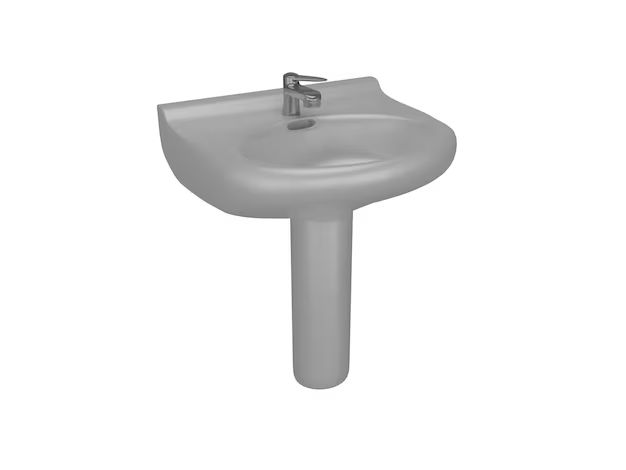When installing a pedestal sink, using the right bolts is crucial for ensuring a secure and long-lasting connection. Selecting the wrong bolts can lead to a wobbly sink or even water damage over time. There are a few key factors to consider when choosing bolts for a pedestal sink installation.
Page Contents
Bolt Type
The most common and recommended bolts for pedestal sinks are brass or stainless steel lag bolts. Lag bolts are designed with a hexagonal head and threaded end that “lags” into the material being fastened. This creates a very strong connection that can handle the weight and pressure of a sink full of water. Brass and stainless steel offer corrosion resistance.
Avoid using standard wood screws, sheet metal screws or self-tapping screws for pedestal sinks. These do not provide as secure of a connection and can loosen or corrode over time.
Bolt Length
The length of the bolts will depend on the thickness of the pedestal sink pedestal and the countertop material it is being attached to. In most cases, bolts between 1 1/4″ and 2″ long will work. Measure the combined thickness of the sink pedestal flange and countertop to determine the best length.
Be sure to get bolts long enough to go through both materials with room for a washer and nut on the underside. Having too short of bolts can prevent a tight connection.
Bolt Diameter
Standard lag bolt diameters for pedestal sinks range from 1/4″ to 3/8″. A 1/4″ diameter is sufficient for most porcelain pedestal sinks. Go with a larger 3/8″ diameter bolt for heavier sinks like cast iron or for additional support.
Do not use bolts that are too narrow or they may not provide enough grip to hold the sink securely.
Number of Bolts
Most pedestal sinks include 4 pre-drilled holes in the pedestal flange that line up with the sink basin above. Use all 4 holes to maximize stability and anchoring of the sink. If there are no pre-drilled holes, space bolts evenly every 3-4 inches around the perimeter of the flange.
Using fewer than 4 bolts can compromise the strength of the connection and lead to rocking or spinning of the sink over time.
Washers
Always use washers with the bolts to prevent pull through. For a pedestal sink, using large 1/2″ or 5/8” diameter washers is recommended. The wide surface area helps disperse pressure instead of the bolts digging into the countertop.
Brass or stainless steel washers are best to match the bolt material.
Tightening the Bolts
Be sure to tighten the bolts gradually and evenly when installing the sink. Tighten diagonally across from each bolt rather than in a circle. Go slowly to allow the pedestal flange to pull down flush against the countertop.
Tighten just to “snug” with a wrench or pliers rather than over-torqueing. Overtightening can crack a sink basin or damage the countertop material.
Recommended Pedestal Sink Bolt Options
Here are some recommended bolt options to use when installing a pedestal sink:
| Bolt Type | Diameter | Length |
|---|---|---|
| Brass lag bolt | 1/4″ | 1 1/4″ to 2″ |
| Stainless steel lag bolt | 3/8″ | 1 1/4″ to 2″ |
Pedestal Sink Base Material Considerations
The material that the pedestal sink will be attached to is an important factor in choosing the right bolts. Here are some tips for different base materials:
Wood Countertops
– Pilot holes are essential in wood to prevent cracking when the bolts are tightened
– Brass or stainless steel bolts are best to avoid corrosion
– Use larger 3/8″ diameter bolts for added grip in wood
Tile Countertops
– May require pre-drilling through tile and using anchors for bolts
– Stainless steel bolts hold up best to moisture from grout and sinks
– Use washers to prevent bolt heads from digging into grout
Laminate Countertops
– Don’t overtighten bolts to avoid buckling the laminate
– Brass bolts provide the most secure grip without scratching
– Use large washers to prevent compression marks
Natural Stone Countertops
– May need special drill bit (carbide or diamond tipped) to pilot holes
– Stainless steel bolts are strongest for heavy stone countertops
– Washers help prevent cracks radiating from bolt holes
Concrete Countertops
– Pre-drill holes and use anchors designed for concrete
– Stainless steel bolts last longer in alkaline concrete conditions
– Use larger 3/8″ diameter bolts for maximum holding in concrete
Tips for a Secure Pedestal Sink Installation
Follow these tips for the most secure pedestal sink installation using bolts:
- Always pre-drill holes for bolts in countertop material
- Use brass or stainless steel bolts for longevity
- Choose 1/4″ or 3/8″ diameter bolts based on sink weight
- Use bolts long enough to go through pedestal flange and countertop
- Include large washers to prevent pull through
- Tighten bolts gradually and evenly – don’t overtighten!
- Consider the countertop material and choose optimal bolts
Conclusion
Installing a pedestal sink securely using the right bolts is an important plumbing task. With the right selection of bolt type, size, length and proper installation technique, your pedestal sink can stay safely and beautifully mounted for years of daily use. Always take care to choose corrosion-resistant bolts, use washers, pre-drill holes and evenly tighten the bolts without overdoing it. Consider the specific sink material and countertop when deciding on bolts. With these tips in mind, you can install a pedestal sink with confidence it will withstand the test of time.
